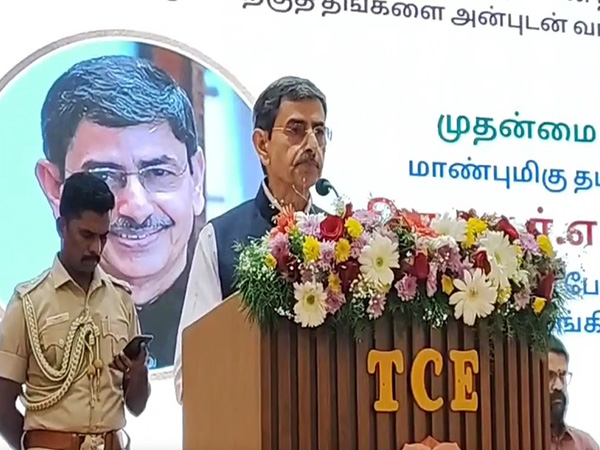Endangered eagle from Mongolia returns to Assam's Kaziranga to breed, 5th year in a row
Apr 08, 2025

Kaziranga (Assam) [India], April 7 : An endangered fishing eagle tagged in Mongolia has been recorded by scientists of Bombay Natural History Society in Kaziranga National Park of Assam on March 16 this year.
After examining the global registry it was learnt that thePallas's fish eagle a male bird with ring A25 and named Ider was tagged at Buuntsagaan Lake in Central Western Mongolia on August 21, 2020, according to Dr Batmunkh of Wildlife Science and Conservation Centre (WSCC).
Since then, Ider returns to Kaziranga National Park each year for breeding and changes nesting location only once. During the non-breeding season, from June to September, Ider visits the Buuntsagaan Lake, Dr Batmunkh said.
Pallas's fish eagle (Haliaeetus leucoryphus), listed as "endangered" on the International Union for Conservation of Nature (IUCN) Red List, is a poorly studied fish eagle across its entire range of fish eagles.
The species was formally considered to be locally common across central and southern Asia. However, according to a report published by BirdLife International, the number has retracted significantly during the 20th century, and the bird is believed to be largely absent from its former stronghold areas such as the Caspian and Kazakhstan.
Due to declining population size, IUCN classified the Pallas's fish eagle as a "vulnerable" species (IUCN, 2016); the conservation status was further downgraded to "endangered" in 2021 (IUCN, 2023). The conservation status was further downgraded to "endangered" in 2021 (IUCN, 2023). The number of mature individuals in the wild is estimated to be around 2,500 to 9,999 (Birdlife International, 2016).
Dr Sonali Ghosh, Field Director of Kaziranga National Park & Tiger Reserve said that, known as one of the largest fishing eagles, Pallas's fish eagle exhibits interesting "reverse migration" behaviour as it breeds in Kaziranga during winter (from November to March) and then migrates to Mongolia every year. "Kaziranga is one of the best locations to watch the Pallas's Fish eagle in the world," Dr Ghosh added.
The Central Asian Flyway (CAF) is one of the nine global waterbird flyways, comprising migratory routes from the northernmost breeding grounds in Siberia to southernmost non-breeding grounds in the West and South Asia, The Maldives and British Indian Ocean Territory (CMS 2005). Covering at least 279 populations of 182 migratory waterbird species, the flyway spans 30 countries of North, Central and South Asia and TransCaucasus (CMS 2019).
India, located at the heart of CAF, hosts approximately 370 migratory bird species from three major flyways, with 310 predominantly using wetland habitats.
"The country's diverse wetlands, spanning 15.26 million hectares, provide critical habitats for over 200 waterbird species. Kaziranga and other wetlands in north-eastern India are important as they serve as wintering grounds for both the CAF and the East Asian-Australasian Flyway (EAAF). While many telemetry studies on raptors investigating their movement and migration patterns have been carried out worldwide, less than one per cent of the total bird species found in India have been studied using satellite telemetry. Hence, very little information exists for the Central Asian Flyway," Dr Ghosh explained. According to her, Kaziranga has had a conservation legacy of over 119 years.
She further added, "With its terrestrial and aquatic habitats, it is one of the finest protected areas in the world. The Tiger Reserve is a popular destination for birders owing to a very high diversity of over 500 bird species. The Tiger Reserve extends over 1,302 square kilometres, with a significant area of over 50 percent of the landmass under grasslands interspersed with water bodies, locally known as beels. These, along with the main channel of the Brahmaputra River, the Dhansiri, the Difloo, and the Laokhowa Suti rivers, are a habitat for both resident and migratory birds."
Kaziranga National Park (IBA Code: IN-AS-03) and Laokhowa and Burhachapori Wildlife Sanctuaries (IBA Code: IN-AS-02) are "two Important Bird Areas (IBAs) in Kaziranga Tiger Reserve (KTR) that are known for being important for waterbirds". The 6th Kaziranga Waterbird Count conducted in KTR on January 11 and 12, 2025, counted 124 species of water and wetland-dependent birds, totalling 112,062 individuals from 25 families across 189 beels. Notably, 62 species were winter migrants.
The IUCN Red List identifies seven species as globally threatened and 15 as near threatened. Key sightings included the Critically Endangered Baer's Pochard and the Endangered Pallas's Fish Eagle. The bar-headed goose had the highest count at 20,845 individuals, whereas five other species--knob-billed duck, Baer's pochard, falcated duck, white-tailed eagle, and greater white-fronted goose--were observed for the first time.
Assam Chief Minister Dr Himanta Biswa Sarma recently posted on X: "The endangered Pallas's Fish Eagle, tagged in Mongolia, has made Kaziranga its breeding ground for five straight years, putting Assam on the map of epic bird migrations. Witnessed these winged wonders."


















